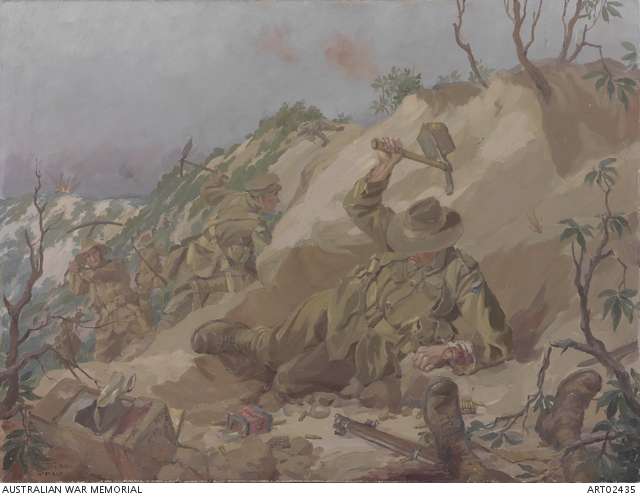The landing
Before dawn on 25 April 1915, an armada of ships assembled off the Gallipoli peninsula to land thousands of troops on the Turkish beaches. ANZAC troops had a vital role: they were to come ashore at Ari Burnu on the southern end of the peninsula before thrusting inland. Here they were to capture a series of ridges before driving all before them to tie in with the main British landings on the peninsula’s tip at Cape Helles.
From the start there were problems in getting the troops ashore, and once on land progress was held up by Turkish defences, high cliffs, steep ridges, deep gullies and thick scrub. The initial assault lost momentum in the face of allied confusion and a well-coordinated Turkish resistance, and was brought to a standstill once enemy reinforcements arrived. The place of the landing was soon named “Anzac” by the allied troops.
Fighting continued relentlessly throughout the following days, as vast numbers of Turkish troops occupied the high ground, inflicting heavy losses on the allied forces. The Turkish soldiers were tough, experienced, and prepared to give their lives to defend their homeland. The commander of Turkish troops on Gallipoli, Mustafa Kemal, would emerge as an outstanding leader and a national hero: he would later become president of the Turkish Republic from 1924 until his death in 1938.
The Turks made a particularly heavy attack on 19 May, but allied machine-guns and rifle-fire defeated them. For his actions in the fierce fighting at Courtney’s Post, Lance Corporal Albert Jacka was awarded Australia’s first Victoria Cross of the war and became a national hero. The battle cost as many as 10,000 Ottoman and roughly 600 Australian and New Zealand casualties. A few days later, a short armistice was arranged to allow for the burial of the dead. The Anzacs could not move forward, nor were the Turks able to drive them into the sea. The campaign devolved into a stalemate.
Activities for research and classroom discussion
Hundreds of soldiers move among the dead and wounded on the beach at Anzac Cove on the day of the landing.
1. Look closely at the photograph above. What words would you use to describe how the men might be feeling?
2. Research Turkish commander Mustafa Kemal. Why was he held in such high esteem in his country?
3. Why was it important for Australian soldiers to wear identity discs?
i. The “P” on the identity disc above stands for presbyterian. Why was it important to record the religion of the soldiers?
ii. Soldiers in the First World War wore two identity discs—discover what each one was used for.
iii. This disc was the only personal effect returned to John Lauder’s mother after his death. What might it have meant to her?
4. Signaller Ellis Silas of the 16th Battalion went ashore at Anzac Cove late in the afternoon of 25 April. He described it as a “magnificent spectacle”, while at the same time feeling sickened by the number of dead and wounded he saw. In the following painting he sought to depict the desperation of a small group of men trying to dig in on Pope’s Hill by nightfall.
i. How do you think Silas' experiences in battle affected his painting of this event?



